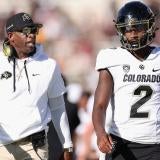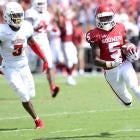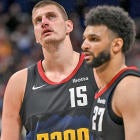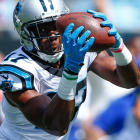Every NFL team is looking for the next Tyreek Hill.
The Kansas City Chiefs electric wideout has 12 plays from scrimmage of 40 or more yards since the start of last year, the most in the NFL.
During that time period, when @cheetah has gone from fun gadget player to legitimate NFL superstar, Hill has averaged 10.95 yards per target, the highest figure in the NFL among receivers with at least 100 targets.
Big play waiting to happen? Yeah, that's Hill.
The next best thing to Hill is Brandin Cooks, who's inexplicably on his third team in three years despite currently being second to Hill in both of those categories -- 40-plus yard plays (10) and yards per target (10.45) since the start of 2017.
After a triumphant run for large receivers at the pro level, the NFL is becoming a small pass-catcher league. From 2013 to 2015, seven of the top 10 receiving touchdown leaders were 6-foot-2 or taller. Since the start of 2016, that's been flipped on its head, as seven of the 10 leaders in receiving scores are 6-1 or shorter. Hill and Cooks trail only Antonio Brown in receiving touchdowns among those shorter than 6-0 in that span.
Oklahoma's Marquise Brown is college football's version of Hill or Cooks. He's turned 52 targets into 716 yards, which equates to a yards-per-target figure of 13.77, currently the second-highest in the nation, per Sports Info Solutions.
And, last year, Brown had 1,095 yards on 83 targets (13.1 yards per target), which means thus far during his time at Oklahoma, Sooners quarterbacks have averaged 13.4 yards when targeting him. Also, he's recorded at least 13 receptions of 40 or more yards in 19 games. Goodness.
Naysayers will point to Tavon Austin as a cautionary tale when regarding small receivers as premier draft prospects.
Will Brown ultimately be closer to Cooks and Hill or bust like Austin did?
Well, before that can be answered, let's compare Cooks and Hill to Austin as prospects. First, from size and athleticism standpoints.
(Percentiles at the receiver position in parentheses)
Tavon Austin | Brandin Cooks | Tyreek Hill* | |
Height/Weight | 5'8"/174 | 5'10"/189 | 5'8"/185 |
40-Yard Dash | 4.34 (95%) | 4.33 (95) | 4.29 (98) |
Vertical | 32" (13) | 36" (58) | 40.5" (93) |
Broad Jump | 120" (49) | 120" (49) | 129" (91) |
Three Cone | N/A | 6.76 (79) | 6.53 (97) |
Short Shuttle | 4.01 (92) | 3.81 (99) | 4.06 (85) |
*Taken from Pro Day, not NFL Combine
Woooo boy. Ridiculous figures across the board for Hill, although they were from his Pro Day. Cooks tested excellently too. The lighter Austin ran really fast and had an awesome short-shuttle time, but his vertical probably should've been a red flag for a player whose game was predicated on explosiveness. I guess Jeff Fisher and the Rams had been hypnotized by Austin's highlight reel and didn't notice.
We won't have Brown's figures until the 2019 Combine of course, but at least the above chart can be referenced then to see where he falls athletically among each end of the small receiver spectrum. He looks sub-4.40 fast and seemingly has elite-level change-of-direction ability.
If you remember back to 2011 and 2012 when watching West Virginia's offense march up and down the field against basically every opponent, Austin was utilized as what was then considered the new-age "offensive weapon." He actually finished his final season in Morgantown with 72 carries.
Hill was mainly a running back during his season at Oklahoma State (102 rushes to 31 receptions), and his final year in college football, at West Alabama, he reeled in 27 passes but also ran the ball 25 times.
Neither were "well-schooled" in the nuances of being a classic wide receiver in the NFL. And, surprisingly, Hill's rookie season in 2016 isn't too dissimilar from the first two campaigns of Austin's career (when their touch totals were somewhat close).
Catches/Yards | Rushes/Yards | Total TD | Yards Per Touch | |
Tavon Austin 2013-2014 | 71/660 | 45/375 | 7 | 8.9 |
Tyreek Hill 2016 | 61/593 | 24/267 | 9 | 10.1 |
However, Austin was essentially a "slot predominant" receiver and gadget runner for the Rams. The Chiefs started to use Hill more like a normal wideout, as his rushing attempts dipped from 24 in 2016 to 17 a season ago, and he ran just 22.4 percent of his routes from the slot , per PlayerProfiler.com. Austin's rushes increased from nine as a rookie to 36 in his second year in the NFL.
At Oregon State, Cooks was frequently aligned on the outside and played in a traditional offense that asked him to run the full route tree, both of which likely had a lot to do with his much quicker transition to the professional game than Austin or Hill. Cooks was on pace for 85 receptions, 880 yards, and nearly five receiving scores as a rookie before his season-ending injury 10 games in.
That's all relevant to this because Brown sees a lot of time on the outside at Oklahoma. He's used on high-percentage screen plays, but he's not half-running back, half-receiver who's needed the space provided by aligning in the slot to be successful. Just 35.7 percent of Brown's targets to date have come from the slot during his time with the Sooners. He has one career carry.
Check the intricacy of Brown's post-comeback route here against Oklahoma State in 2017 (at bottom of the screen). Note how he was able to catch the ball with his hands away from his body too.
He showed much of the same later in last year's rivalry game against the Cowboys on a comeback route from one of the perimeter receiver positions.
Brown got an inside release, accelerated upfield, stopped on a dime, then plucked the ball out of the air on a throw that was above his head when it arrived.
Oklahoma's offense is becoming more of the norm in the NFL than its old reputation as a works-in-college-only spread scheme. And while getting Brown the ball in space on screens or go routes is certainly practical for someone with his burst and long speed, he's shown more than enough ability to win in classic ways at receiver.
About a half of the 2018 college season remains, which will provide more of Brown's film to analyze. But based on what he's demonstrated at Oklahoma so far, there's a much better chance the small, dynamic receiver is the next Tyreek Hill or Brandin Cooks than the next Tavon Austin.





















